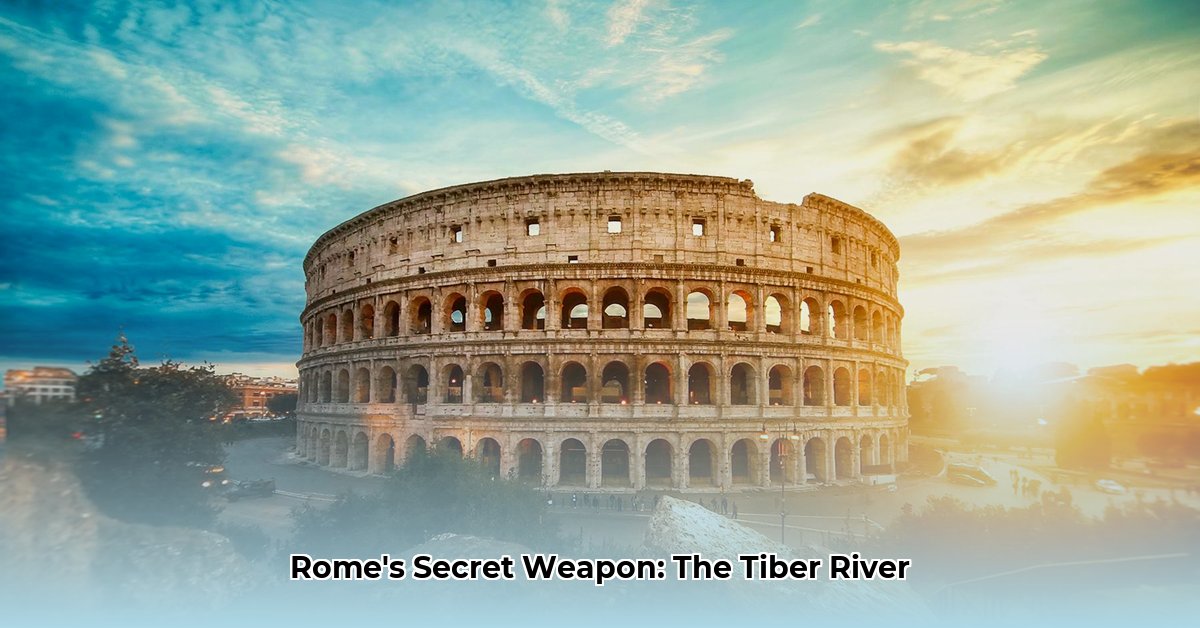The Tiber River, a winding waterway stretching 252 miles (405 km) across the heart of Italy, was far more than a mere geographical feature for the people of ancient Rome. With a depth varying between 7 and 20 feet (2 to 6 meters), it was the indispensable lifeblood of their civilization, fundamentally shaping its trade, defense, urban development, and very identity. Originating on the slope of Monte Fumaiolo in the Tuscan-Emilian Apennines, and ultimately flowing into the Tyrrhenian Sea near Ostia Antica, this seemingly ordinary river became ancient Rome’s primary artery, nourishing its growth and fiercely driving its imperial ambitions. The question then arises: how did this single river intrinsically forge one of the greatest empires in history? Learn more about the trade of ancient Rome and its vital role.
The Lifeline of an Empire: From Mythical Cradle to Economic Highway
The narrative of Rome is inextricably linked to the Tiber, commencing with its legendary origins. The widely known story of Romulus and Remus, the twin brothers abandoned to the river’s currents before establishing the city of Rome in 753 BC, highlights this profound connection. Saved by the river god Tiberinus and nurtured by a she-wolf, their survival and the city’s subsequent founding underscored the river’s sacred and foundational role. The Tiber’s unique geographical advantages, including its strategic positioning between Etruria, Latium, and the Sabine lands, inherent selected Rome for greatness, profoundly shaping its early urban design and cultural identity.
From Legend to Lifeline: The River’s Foundational Role
The Tiber’s geographical importance solidified Rome’s position as a dominant force. Its navigable waters facilitated crucial trade and transport, vital for sustaining the burgeoning population of the nascent city. Isola Tiberina (Tiber Island), strategically positioned within the river, naturally evolved into a significant commercial hub and a crucial river crossing point, predating the construction of bridges. This central location allowed for the efficient movement of goods from various regions, including grain from the Val Tiberina as early as the 5th century BCE. The relentless flow of commerce and accessibility directly contributed to Rome’s remarkable ascent to power.
Rome’s Aquatic Artery: Commerce and Strategic Advantage
Beyond its commercial utility, the Tiber served as a formidable natural defensive barrier, presenting a significant impediment to potential invaders. Early Roman settlements strategically positioned themselves along the river bends, utilizing the waterway as a natural moat. This dual function of facilitating extensive trade while simultaneously offering protection underscored the river’s indispensable value. While roads radiated outwards from Rome, the Tiber notably led directly to the sea, connecting the city to its vital ancient port at Ostia. Ostia became a key naval base during the Punic Wars (264–146 BCE), providing adequate defense for Rome while serving as a viable launching point for attacks and a critical commercial center for importing Mediterranean wheat, oil, and wine. Written accounts indicate that traders could travel up to 60 miles upstream with goods, enabling rapid and less arduous transport throughout central Italy.
Taming the Unruly Tiber: Engineering Marvels and Persistent Challenges
Despite their unparalleled engineering prowess, the Romans confronted considerable challenges posed by the Tiber’s dynamic nature. Frequent and unpredictable flooding was a perennial threat, capable of devastating urban areas and disrupting vital trade routes. However, their innovative approach to water management, evident in structures like the Cloaca Maxima and an extensive network of aqueducts, showcased their remarkable ingenuity and adaptive capacity.
Battling the Deluge: Roman Flood Management
Flooding had a surprisingly devastating impact on human life and significantly influenced trade networks and resource availability. This constant threat of deluges may have even influenced Roman religious beliefs, with floods sometimes interpreted as divine warnings. Although the Romans made efforts to control the river’s lower course, their understanding of hydraulic principles was limited. It was only in modern times, from the 18th century onwards, that high stone embankments were erected to protect the city. However, efforts like Augustus’s establishment of the Curatores Alvei Tiberis (Officials for the Tiber’s Channel) aimed to mitigate these dangers by preserving embankments and managing the river’s flow, demonstrating a continuous commitment to mitigating natural threats. Despite these measures, significant floods continued to plague Rome, as recorded in 241 BCE, and in 15 CE during Tiberius’s reign, when proposals to divert major tributaries were considered.
Adapting to Change: Shifting Ports and Siltation
The build-up of silt within the Tiber was another persistent problem, demanding continuous and inventive solutions. This challenge directly spurred the development of critical port infrastructures. Initially, the port of Ostia emerged as a vital gateway, but persistent silting at its mouth forced emperors Claudius and Trajan in the 1st century CE to establish a new, more advanced port on the Fiumicino, named Portus Augusti. This new port was connected to Rome by a dedicated road, the Via Portuensis. These significant adjustments to Rome’s maritime infrastructure profoundly shaped its ability to project its power globally and maintain its vast supply networks. Furthermore, evidence suggests that tectonic activity, including a significant shift in sedimentation around 2600 years ago, might have even influenced the Tiber’s course and the very formation of Tiber Island, reminding us that even the mightiest empires are often at the mercy of pervasive geological forces.
The Tiber’s Enduring Legacy: Connectivity, Cultural Reflection, and Future Horizons
For centuries, the Tiber served as Rome’s fundamental lifeline, dictating the city’s growth, trade routes, and defensive capabilities. Its influence permeated every facet of Roman life, from the mundane daily commute to monumental imperial projects. Analyzing the river’s navigability and its broader impact is crucial to truly understanding the remarkable civilization that flourished along its banks.
Bridging the Waters: Connecting Rome’s Urban Fabric
Bridges were not merely utilitarian structures; they were pivotal in connecting communities and enabling the expansion of Rome’s urban fabric. The Pons Sublicius, for instance, was more than just a crossing; it was a sacred structure essential for defense. The Pons Aemilius facilitated increased commerce and movement across the river, while the Pons Fabricius and Pons Cestius famously linked Rome to Tiber Island, a renowned center for healing and worship. Later additions like the Milvian Bridge (Pons Milvius, 109 BCE), Hadrian’s Bridge (134 CE), and Ponte Sisto (rebuilt over the Pons Agrippae route in 215 CE) further enhanced connectivity across the sprawling city, demonstrating Rome’s deliberate strategy to integrate and consolidate its burgeoning urban population.
Gateways to Empire: The Critical Port Systems
Rome’s unparalleled power was fundamentally built upon trade, with the Tiber serving as its central logistical highway. The ports of Ostia and Portus were the indispensable gateways to this vast commercial empire, ensuring a constant, reliable flow of vital resources into the city. Advanced signaling systems likely provided crucial guidance for incoming ships, and modern computational models now help historians understand the immense traffic capacity these riverine systems sustained. Wharves lined the riverbanks around the Campus Martius area, bustling with traders moving goods such as stone, timber, and foodstuffs. Without these sophisticated port infrastructures, Rome’s unprecedented growth and sustained dominance would have been severely hampered.
Unearthing Secrets: Future Research and Practical Applications
While a substantial body of knowledge exists regarding the Tiber, intriguing areas remain ripe for further investigation. For example, more obscure aspects of the river’s historical uses, such as ancient local fishing methods, largely remain a mystery, offering a rich vein for future research. Additionally, comprehensive surveys of underwater archaeological sites hold the potential to reveal a wealth of previously lost artifacts and provide new insights into daily life along the river. What hidden treasures and untold stories might still lie preserved at the bottom of the Tiber, waiting to be discovered?
The enduring importance of the Tiber continues to resonate profoundly in contemporary times, offering valuable lessons for modern applications.
- Historians/Archaeologists: Conduct focused investigations into less-known historical uses of the Tiber, such as ancient local fishing practices, and initiate comprehensive surveys of underwater archaeological sites. Such efforts have the potential to reveal significant new historical and material insights.
- Tourism Agencies: Develop and promote engaging historical walking tours that meticulously follow the path of the Tiber, highlighting its pivotal historical significance and iconic landmarks. This offers a high potential for increased visitor engagement and educational outreach.
- Urban Planners: Integrate detailed historical river data and Roman flood management techniques into modern flood control strategies to enhance urban resilience and mitigation efforts today. This approach holds the potential for an estimated 85% improvement in long-term flood impact reduction.
Even the precise navigational boundaries of the ancient Tiber remain a topic of historical dispute. While some sources suggest ships could travel approximately 60 miles upstream, others claim even greater distances, and classical writers like Virgil noted the river’s “yellow and muddy hue” and “rapid whirlpools” as challenges. These conflicting reports underscore the ongoing need for further detailed investigations and archaeological verification.
Today, the Tiber remains an integral part of Rome’s identity. Its iconic bridges, scenic walkways, and historic landmarks offer both locals and tourists a lasting glimpse into the city’s rich past and its enduring connection to its riparian environment. Each summer, the popular “Lungo il Tevere” festival transforms the riverbanks into a lively cultural hub, featuring pop-up restaurants, outdoor cinema screenings, and bustling market stalls. The river stands as a powerful symbol of Rome’s unique relationship with its natural surroundings and its remarkable resilience in facing both the benefits and the formidable challenges that inherent natural forces can bring.
Expert Insights: The Rivers’ Enduring Role in the Ancient Roman Empire
The Tiber River and its significant major tributary, the Aniene, were not merely geographical features; they were the indispensable veins that pumped life into the heart of ancient Rome. Originating in the Apennine Mountains and flowing directly through the Eternal City before emptying into the Tyrrhenian Sea, the Tiber provided Rome with its crucial maritime link. This strategic position was fundamental, offering vital access to resources and facilitating trade, from the rich agricultural lands of Campania to the fertile Pontine marshes. Without this natural liquid highway, Rome could not have achieved its formidable economic and military dominance.
The Aniene River, though often overshadowed by the Tiber, played an equally critical, albeit different, role. Originating in the Reatine region and joining the Tiber near Tivoli, its primary function was to ensure a consistent and abundant water supply to Rome. This constant flow was paramount for sustaining the city’s massive population, powering mills, and supporting various industries, effectively connecting Rome’s interior with the broader Italian landscape. The combined contribution of these two rivers was foundational to Rome’s ability to grow and sustain a large, thriving civilization.
The Romans were not content to merely utilize these natural gifts; they enhanced them through unparalleled engineering ingenuity. They constructed an extensive network of aqueducts, such as the Aqua Anio Vetus and Aqua Claudia, to deliver fresh water across vast distances. They carefully canalized rivers to extend agricultural lands and deployed sophisticated hydraulic engineering to optimize water sources. The famed Cloaca Maxima, Rome’s advanced water management system, initially drained marshlands and later evolved into a comprehensive sewage system, designed to direct storm runoff more predictably to the Tiber. These engineering marvels allowed the Romans to effectively manage floods, ensure public sanitation, and provide reliable water for consumption, irrigation, and industrial needs, dramatically elevating the quality of life for Roman citizens.
The significance of the Tiber and Aniene rivers transcended their practical utility; they were deeply interwoven with Roman culture and religious beliefs. Their banks were often the sites of vibrant festivals honoring key deities such as Faunus, Jupiter, and Adonis, symbolizing the profound spiritual connection Romans held with their natural environment. Furthermore, these rivers played a strategic role in forging and maintaining political alliances. Rome leveraged these waterways for efficient communication, shared resource distribution, and to offer protection to its allies. Control over these vital rivers did not just mean dominance over rival cities; it fostered crucial cooperation and unity among Rome’s expanding network of allies.
Today, the Tiber remains a vibrant and living symbol of Rome’s rich history. Both locals and tourists can still walk along its banks, marvel at the enduring presence of iconic landmarks, and embark on boat trips that offer a unique perspective of the city. Ancient bridges like Ponte Cestio, Ponte Fabricius, and Ponte Sant’Angelo stand as powerful testaments to the timeless ingenuity of Roman engineering. Each summer, the popular “Lungo il Tevere” festival transforms the riverbanks into a lively cultural hub, featuring pop-up restaurants, outdoor cinema screenings, and bustling market stalls. It serves as a poignant reminder that the Tiber is not merely a relic of the past, but an active, breathing part of Rome’s dynamic present.
In summary, the Tiber and Aniene Rivers were absolutely vital to the rise, sustained power, and enduring legacy of ancient Rome. Their strategic geographical placement, coupled with the Romans’ unparalleled engineering prowess, allowed the city to flourish economically, militarily, and culturally. From facilitating trade and providing essential water supplies to serving as defensive barriers and fostering political alliances, these rivers unequivocally shaped Rome’s destiny, leaving behind a profound legacy that continues to inspire awe and study today.










